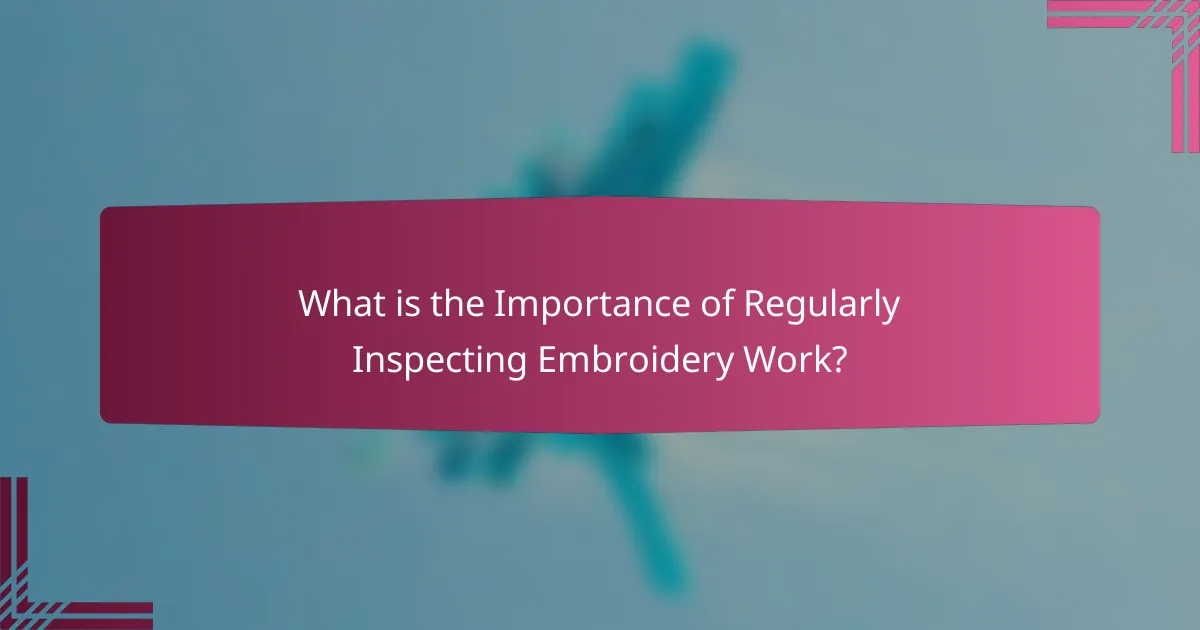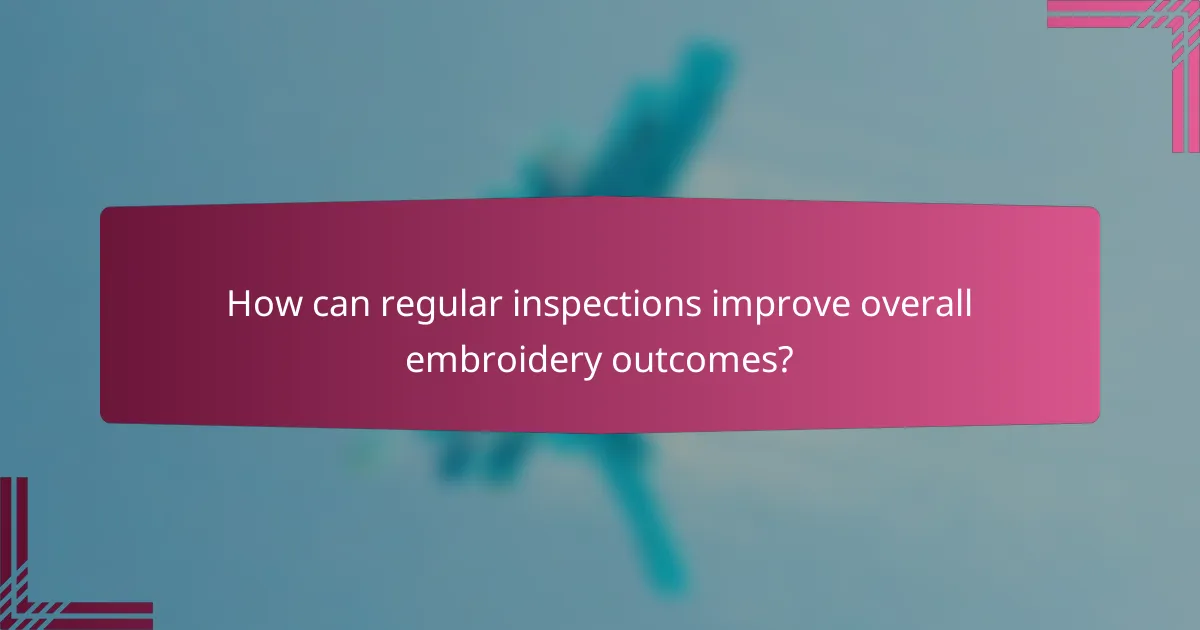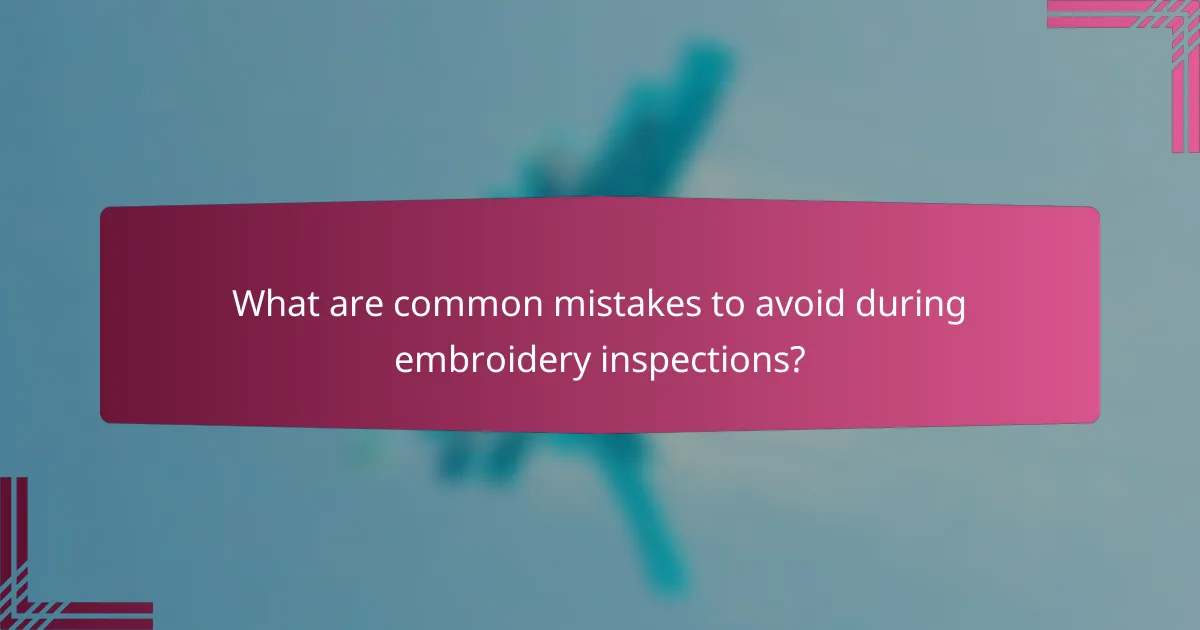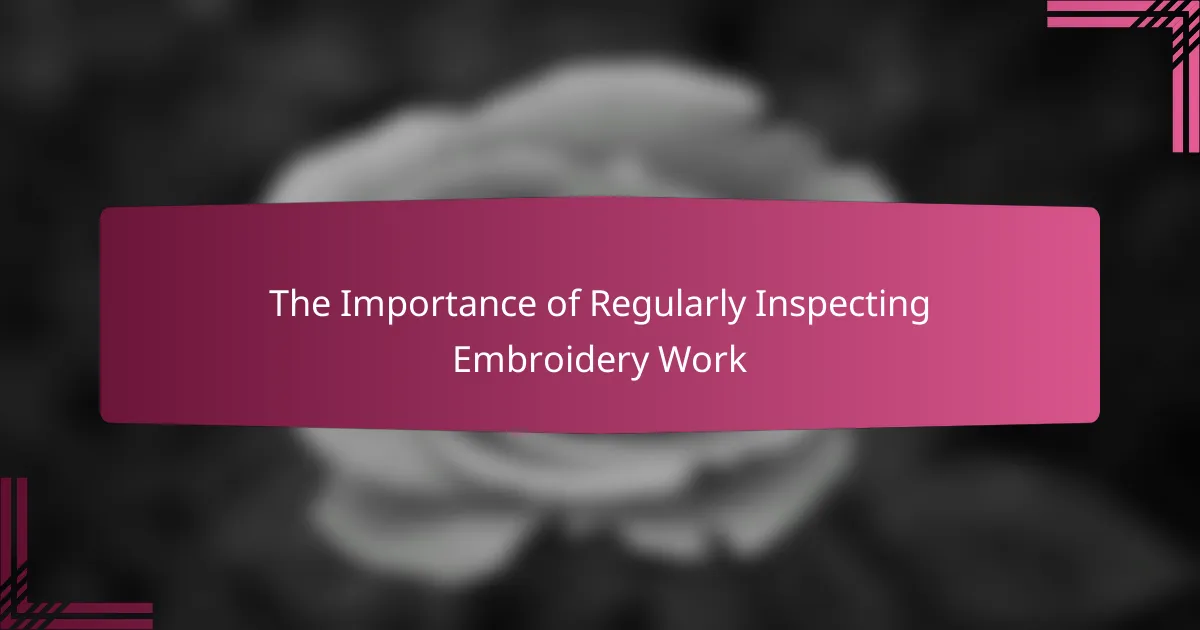
What is the Importance of Regularly Inspecting Embroidery Work?
Regularly inspecting embroidery work is crucial for maintaining quality and ensuring durability. Inspections help identify mistakes such as misaligned stitches or thread breaks. Detecting these issues early prevents further damage and costly repairs. Regular checks also ensure that the design aligns with initial specifications. Quality control during production enhances customer satisfaction. Consistent inspections can extend the lifespan of the finished product. Studies show that quality assurance practices can reduce defects by up to 50%. Therefore, regular inspection is essential for high-quality embroidery work.
Why is regular inspection crucial for embroidery quality?
Regular inspection is crucial for embroidery quality because it ensures consistency and precision in the finished product. This process identifies defects early, preventing costly rework. Regular checks help maintain thread tension, stitch density, and color accuracy. Additionally, inspections confirm that design specifications are met. According to industry standards, a 1% defect rate can significantly impact customer satisfaction. Thus, consistent quality control through regular inspection enhances overall product reliability and brand reputation.
What specific issues can arise from neglecting inspection?
Neglecting inspection of embroidery work can lead to several specific issues. First, it may result in undetected defects in stitching. These defects can compromise the overall quality of the finished product. Second, fabric damage may occur, which can be costly to repair or replace. Third, neglecting inspection can cause misalignment of design elements, leading to unsatisfactory visual outcomes. Additionally, quality control failures may result in customer dissatisfaction and loss of business. Studies indicate that regular inspections can reduce defect rates by up to 30%. Thus, neglecting inspection can have significant negative impacts on product quality and customer retention.
How does inspection impact the longevity of embroidery work?
Regular inspection significantly enhances the longevity of embroidery work. It allows for the early detection of issues such as loose threads or fabric wear. Addressing these problems promptly prevents further damage. Regular checks can also ensure that the stitching remains intact and consistent. This practice maintains the overall quality of the embroidery. Studies show that well-maintained embroidery can last up to 25 years longer than poorly inspected pieces. Consistent inspection ultimately preserves the aesthetic and structural integrity of the work.
What are the key aspects to consider during inspection?
Key aspects to consider during inspection include fabric integrity, thread tension, and stitch quality. Inspecting fabric integrity ensures there are no tears or stains. Thread tension affects the overall appearance and durability of the embroidery. Proper stitch quality is crucial for a professional finish. Additionally, alignment and design accuracy should be checked. These aspects contribute to the overall quality of the embroidery work. Regular inspections can prevent costly mistakes and ensure customer satisfaction.
How do thread tension and stitch integrity affect embroidery quality?
Thread tension and stitch integrity significantly impact embroidery quality. Proper thread tension ensures that stitches are evenly formed and prevents puckering. When tension is too loose, stitches can become loose and may unravel. Conversely, excessive tension can lead to thread breakage or fabric damage. Stitch integrity refers to the strength and consistency of the stitches. High stitch integrity means that stitches hold well under stress and maintain their appearance over time. Poor stitch integrity can result in fraying or distortion of the design. Regular inspection of thread tension and stitch integrity is essential for achieving high-quality embroidery results.
What role does colorfastness play in embroidery inspection?
Colorfastness is crucial in embroidery inspection as it determines how well the colors in the embroidery withstand washing, light, and other environmental factors. High colorfastness ensures that the embroidery maintains its intended appearance over time. This characteristic is essential for quality assurance in textile products. Inspections typically include tests for colorfastness to evaluate durability. For example, the AATCC 61 test measures colorfastness to laundering. Products failing this test may show significant color bleeding or fading. Regular inspections help identify such issues before products reach consumers. Maintaining high standards in colorfastness contributes to customer satisfaction and brand reputation.

How can regular inspections improve overall embroidery outcomes?
Regular inspections enhance overall embroidery outcomes by identifying issues early in the production process. This proactive approach allows for timely corrections, reducing the likelihood of defects. Inspections help maintain consistent quality across all pieces. They ensure that thread tension and color matching are accurate, which is vital for professional results. Regular checks can also prevent costly rework or material waste. Studies show that quality control measures, including inspections, can increase customer satisfaction by up to 30%. By implementing regular inspections, businesses can improve efficiency and maintain a strong reputation in the market.
What benefits does regular inspection provide to embroiderers?
Regular inspection provides several benefits to embroiderers. It ensures quality control in the finished products. Regular checks can identify defects early in the production process. This helps in reducing waste and saving costs. Inspections also maintain consistent embroidery standards. They enhance customer satisfaction by ensuring high-quality outcomes. Additionally, regular inspections can improve the efficiency of the workflow. This leads to timely project completion and better resource management. Overall, these practices contribute to the longevity and reputation of the embroidery business.
How does it enhance customer satisfaction and trust?
Regular inspection of embroidery work enhances customer satisfaction and trust by ensuring high-quality output. Consistent quality checks prevent defects in the final product. This reliability fosters a sense of confidence among customers. When clients receive flawless embroidery, they are more likely to return for future orders. Statistics show that 70% of customers value quality assurance in their purchases. Additionally, transparent inspection processes build credibility. Customers appreciate knowing that their products are meticulously checked. This transparency strengthens the relationship between the business and its clientele.
What financial savings can be realized through regular inspections?
Regular inspections can lead to significant financial savings in embroidery work. By identifying defects early, businesses can reduce the costs associated with rework and material waste. For instance, a study found that proactive inspections can decrease production errors by up to 30%. This reduction translates to lower labor costs and less expenditure on raw materials. Additionally, regular inspections can enhance product quality, leading to higher customer satisfaction and repeat business. Improved quality can increase sales by as much as 20%. Overall, the financial benefits of regular inspections in embroidery work are substantial, as they help prevent costly mistakes and enhance profitability.
What tools and techniques are effective for inspecting embroidery work?
Effective tools for inspecting embroidery work include magnifying glasses, light boxes, and stitch counters. Magnifying glasses help identify flaws in stitching and ensure precision. Light boxes provide even illumination, revealing inconsistencies in thread color and tension. Stitch counters assist in verifying the number of stitches, ensuring patterns are accurately followed. Techniques such as visual inspection and tactile assessment further enhance quality control. Visual inspection involves closely examining the embroidery for any irregularities. Tactile assessment includes feeling the texture to ensure uniformity. These tools and techniques together promote high-quality embroidery results.
How can technology aid in the inspection process?
Technology aids in the inspection process by enhancing accuracy and efficiency. Automated systems can quickly identify defects in embroidery patterns. High-resolution cameras capture detailed images for analysis. Software algorithms analyze these images for quality control. Data analytics tools track inspection results over time. This leads to improved decision-making and process adjustments. Technologies like RFID streamline inventory management during inspections. Overall, technology reduces human error and increases inspection speed.
What manual methods are recommended for thorough inspections?
Visual inspection is a recommended manual method for thorough inspections. This method involves closely examining the embroidery for flaws, such as loose threads or uneven stitching. Inspectors should use good lighting to enhance visibility. They can also utilize magnifying tools to identify small defects. Another method is tactile inspection, where inspectors feel the texture of the fabric and stitching. This helps detect inconsistencies that may not be visible. Additionally, a checklist can guide inspectors through the process. Checklists ensure that all aspects of the embroidery are reviewed systematically. These manual methods are essential for maintaining quality in embroidery work.

What are common mistakes to avoid during embroidery inspections?
Common mistakes to avoid during embroidery inspections include overlooking thread tension issues. Incorrect tension can lead to puckering or uneven stitching. Failing to check for color consistency is another mistake. Inconsistent colors can affect the overall appearance of the embroidery. Inspectors often miss checking for proper backing material. Inadequate backing can cause distortion or damage to the fabric. Not verifying the design placement is also a frequent error. Misalignment can ruin the intended design. Additionally, neglecting to examine for loose threads is a common oversight. Loose threads can create a messy look and may lead to unraveling. Lastly, skipping a final quality check before approval can result in unnoticed flaws. These mistakes can significantly impact the quality of the final product.
What pitfalls do embroiderers often encounter when inspecting their work?
Embroiderers often encounter several pitfalls when inspecting their work. One common issue is overlooking small errors, such as misaligned stitches. This can lead to an overall unprofessional appearance. Another pitfall is failing to check for thread tension. Incorrect tension can result in puckering or loose threads. Additionally, embroiderers may neglect to inspect the back of the work. The back can reveal hidden mistakes that affect the final product’s quality. Lastly, inadequate lighting during inspection can cause missed flaws. Proper lighting is crucial for identifying issues accurately. These pitfalls can compromise the quality of the embroidery. Regular inspection helps mitigate these problems and ensures a polished finish.
How can overlooking minor details lead to major issues?
Overlooking minor details in embroidery work can result in significant issues. Small errors, such as misaligned stitches or incorrect thread colors, may seem trivial. However, these mistakes can accumulate and lead to a flawed final product. For example, a single misplaced stitch can disrupt the overall design. This can result in customer dissatisfaction and potential loss of business. Additionally, unresolved minor issues may require costly rework or complete restitching. Regular inspection helps identify and rectify these details before they escalate. This proactive approach ensures high-quality outcomes and maintains brand reputation.
What are the consequences of inadequate inspection procedures?
Inadequate inspection procedures can lead to significant quality issues in embroidery work. Poor inspections may result in undetected errors such as misaligned designs or faulty stitching. This can compromise the overall aesthetic and functionality of the finished product. Additionally, inadequate inspections can increase production costs due to rework or waste. According to a study by the American Society for Quality, organizations that neglect quality inspections can face up to 30% higher operational costs. Furthermore, customer dissatisfaction may arise, leading to loss of business and damage to brand reputation. Ultimately, the lack of proper inspection procedures can severely impact both product quality and financial performance.
What best practices should be followed for effective embroidery inspection?
Effective embroidery inspection requires following specific best practices. First, ensure proper lighting in the inspection area. Good lighting helps identify flaws and inconsistencies. Second, use a magnifying glass or loupe to examine intricate details. This tool reveals small defects that might be missed. Third, inspect the stitching density and consistency across the entire design. Uneven stitching can affect the overall appearance. Fourth, check for color accuracy and alignment with design specifications. Color discrepancies can lead to dissatisfaction. Fifth, assess the backing material for stability and support. A weak backing can cause embroidery to distort over time. Finally, document findings and corrective actions taken. This creates a quality control record that can be referenced in future inspections.
How can creating a checklist streamline the inspection process?
Creating a checklist can streamline the inspection process by providing a structured format for evaluations. Checklists ensure that all necessary criteria are reviewed consistently. They minimize the risk of overlooking important details during inspections. By standardizing the inspection steps, checklists enhance efficiency and save time. Additionally, they facilitate communication among team members by clearly outlining expectations. Research shows that using checklists can increase compliance rates by up to 30%. This structured approach leads to more thorough and accurate inspections overall.
What routine should be established for regular inspections?
A routine for regular inspections of embroidery work should include weekly checks. Inspectors should evaluate the quality of stitching and thread tension. They should also assess color accuracy and fabric integrity. Documenting findings is crucial for tracking progress. Implementing corrective actions for any identified issues is necessary. Regular training for inspectors enhances inspection effectiveness. This routine helps maintain high-quality standards in embroidery work. Consistent inspections lead to reduced errors and improved customer satisfaction.
The main entity of the article is the practice of regularly inspecting embroidery work. The article emphasizes the importance of inspections for maintaining quality, identifying defects, and ensuring durability in embroidery products. It outlines the specific issues that can arise from neglecting inspections, such as misalignment and fabric damage, and highlights how regular checks can enhance longevity and customer satisfaction. Key aspects of inspection, including thread tension, stitch integrity, and colorfastness, are discussed, along with best practices and the financial benefits associated with effective inspection procedures.
